engine RENAULT TWIZY 2018 Owners Manual
[x] Cancel search | Manufacturer: RENAULT, Model Year: 2018, Model line: TWIZY, Model: RENAULT TWIZY 2018Pages: 118, PDF Size: 2.51 MB
Page 7 of 118
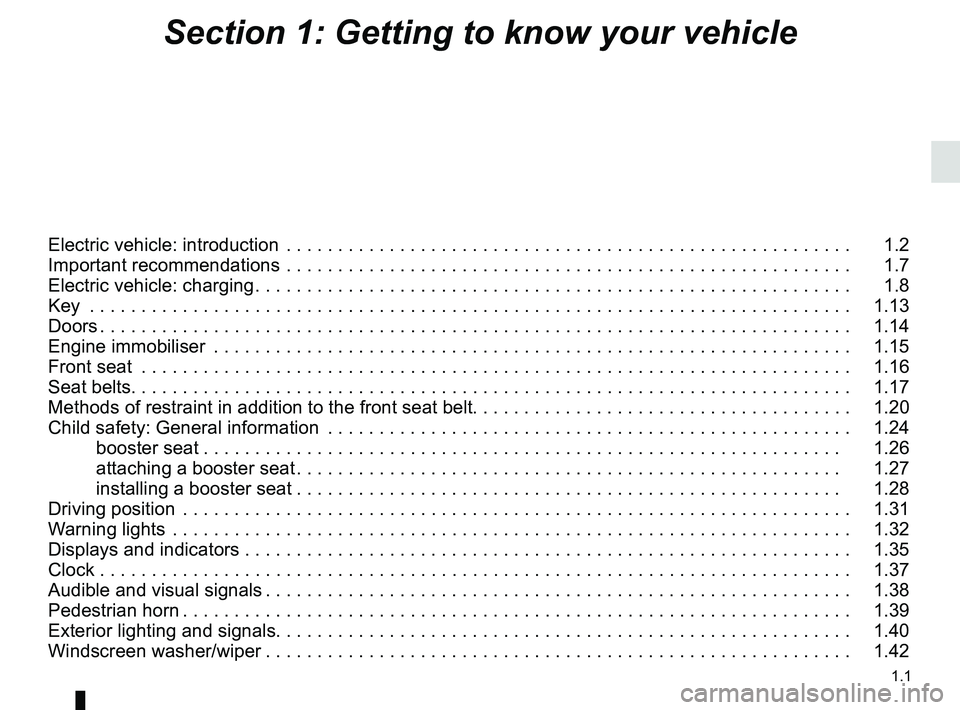
1.1
Section 1: Getting to know your vehicle
Electric vehicle: introduction . . . . . . . . . . . . . . . . . . . . . . . . . . . . . . . . . . . .\
. . . . . . . . . . . . . . . . . . . 1.2
Important recommendations . . . . . . . . . . . . . . . . . . . . . . . . . . . . . . . . . . . .\
. . . . . . . . . . . . . . . . . . . 1.7
Electric vehicle: charging . . . . . . . . . . . . . . . . . . . . . . . . . . . . . . . . . . . . \
. . . . . . . . . . . . . . . . . . . . . . 1.8
Key . . . . . . . . . . . . . . . . . . . . . . . . . . . . . . . . . . . .\
. . . . . . . . . . . . . . . . . . . . . . . . . . . . . . . . . . . . . . 1.13
Doors . . . . . . . . . . . . . . . . . . . . . . . . . . . . . . . . . . . . \
. . . . . . . . . . . . . . . . . . . . . . . . . . . . . . . . . . . . . 1.14
Engine immobiliser . . . . . . . . . . . . . . . . . . . . . . . . . . . . . . . . . . . .\
. . . . . . . . . . . . . . . . . . . . . . . . . . 1.15
Front seat . . . . . . . . . . . . . . . . . . . . . . . . . . . . . . . . . . . .\
. . . . . . . . . . . . . . . . . . . . . . . . . . . . . . . . . 1.16
Seat belts. . . . . . . . . . . . . . . . . . . . . . . . . . . . . . . . . . . . \
. . . . . . . . . . . . . . . . . . . . . . . . . . . . . . . . . . 1.17
Methods of restraint in addition to the front seat belt. . . . . . . . . . . . . . . . . . . . . . . . . . . . . . . . . . . . \
. 1.20
Child safety: General information . . . . . . . . . . . . . . . . . . . . . . . . . . . . . . . . . . . .\
. . . . . . . . . . . . . . . 1.24 booster seat . . . . . . . . . . . . . . . . . . . . . . . . . . . . . . . . . . . . \
. . . . . . . . . . . . . . . . . . . . . . . . . . 1.26
attaching a booster seat . . . . . . . . . . . . . . . . . . . . . . . . . . . . . . . . . . . . \
. . . . . . . . . . . . . . . . . 1.27
installing a booster seat . . . . . . . . . . . . . . . . . . . . . . . . . . . . . . . . . . . . \
. . . . . . . . . . . . . . . . . 1.28
Driving position . . . . . . . . . . . . . . . . . . . . . . . . . . . . . . . . . . . .\
. . . . . . . . . . . . . . . . . . . . . . . . . . . . . 1.31
Warning lights . . . . . . . . . . . . . . . . . . . . . . . . . . . . . . . . . . . .\
. . . . . . . . . . . . . . . . . . . . . . . . . . . . . . 1.32
Displays and indicators . . . . . . . . . . . . . . . . . . . . . . . . . . . . . . . . . . . .\
. . . . . . . . . . . . . . . . . . . . . . . 1.35
Clock . . . . . . . . . . . . . . . . . . . . . . . . . . . . . . . . . \
. . . . . . . . . . . . . . . . . . . . . . . . . . . . . . . . . . . . . . . . 1.37
Audible and visual signals . . . . . . . . . . . . . . . . . . . . . . . . . . . . . . . . . . . . \
. . . . . . . . . . . . . . . . . . . . . 1.38
Pedestrian horn . . . . . . . . . . . . . . . . . . . . . . . . . . . . . . . . . . . . \
. . . . . . . . . . . . . . . . . . . . . . . . . . . . . 1.39
Exterior lighting and signals. . . . . . . . . . . . . . . . . . . . . . . . . . . . . . . . . . . . \
. . . . . . . . . . . . . . . . . . . . 1.40
Windscreen washer/wiper . . . . . . . . . . . . . . . . . . . . . . . . . . . . . . . . . . . . \
. . . . . . . . . . . . . . . . . . . . . 1.42
Page 11 of 118

1.5
ELECTRIC VEHICLE: introduction (4/5)
For safety reasons, adapt
your driving to driving condi-
tions and avoid any sudden
turning of the steering
wheel, especially on steep slopes or
slippery surfaces.
Failure to respect these recommen-
dations may lead to a loss of control
of the vehicle.
Risk of accident and serious injury.
Obstructions to the driver
On the driver’s side, only
use mats suitable for the
vehicle, attached with the
pre-fitted components, and check
the fitting regularly. Do not lay one
mat on top of another.
There is a risk of wedging the
pedals.
Having a passenger effects
vehicle balance, road hold-
ing and increases the vehi-
cle braking distance.
Adapt your driving to the driving
conditions and avoid any sudden
manoeuvre which could lead to a
loss of control over the vehicle. Risk
of accident and serious injury.
Driving
When you lift your foot off the accelera-
tor pedal, the motor generates electri-
cal current during deceleration, and this
energy is used to recharge the traction
battery. Please refer to the information
on the “Charge meter” in Section 2.
An electric motor generates a greater
engine brake than in a petrol or diesel
engine vehicle.
Page 12 of 118
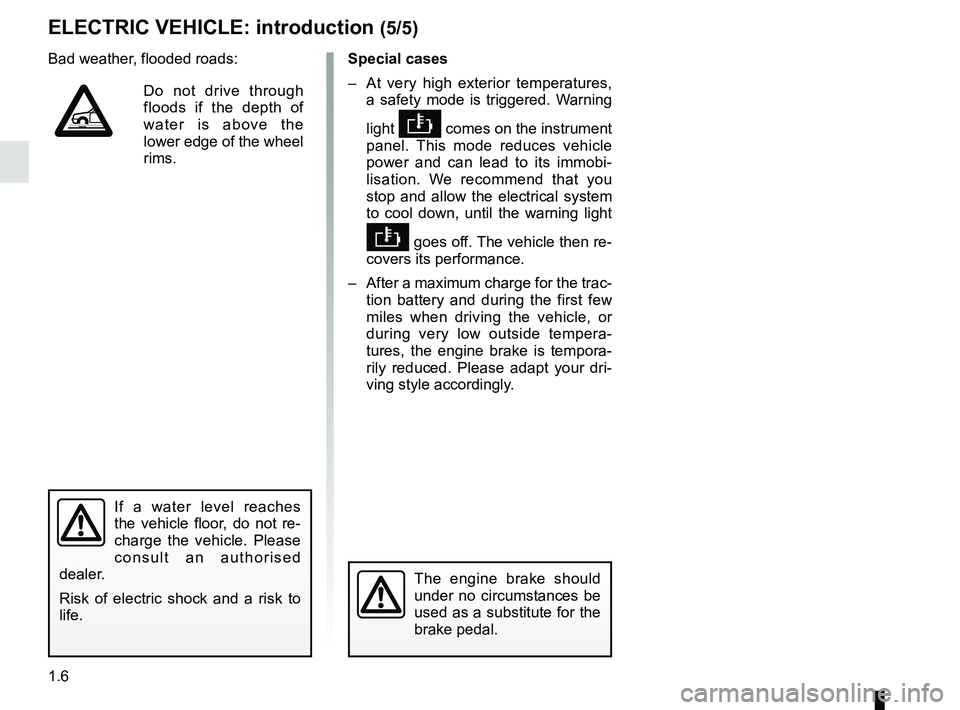
1.6
Special cases
– At very high exterior temperatures, a safety mode is triggered. Warning
light
comes on the instrument
panel. This mode reduces vehicle
power and can lead to its immobi-
lisation. We recommend that you
stop and allow the electrical system
to cool down, until the warning light
goes off. The vehicle then re-
covers its performance.
– After a maximum charge for the trac- tion battery and during the first few
miles when driving the vehicle, or
during very low outside tempera-
tures, the engine brake is tempora-
rily reduced. Please adapt your dri-
ving style accordingly.
The engine brake should
under no circumstances be
used as a substitute for the
brake pedal.
Bad weather, flooded roads:
Do not drive through
floods if the depth of
water is above the
lower edge of the wheel
rims.
If a water level reaches
the vehicle floor, do not re-
charge the vehicle. Please
consult an authorised
dealer.
Risk of electric shock and a risk to
life.
ELECTRIC VEHICLE: introduction (5/5)
Page 19 of 118

1.13
KEY
Key
A Coded ignition-starter key, locking/
unlocking storage compartments.
The key must not be used for any
function other than those described
in the handbook (removing the cap
from a bottle, etc.).
Replacement, requirements for
additional keys
If you lose your key or require an-
other, you can obtain one exclu-
sively from an authorised dealer.
A
Driver’s responsibility
when parking or stopping
the vehicle
Never leave an animal,
child or adult who is not self-suffi-
cient alone on your vehicle, even for
a short time.
They may pose a risk of injury, such
as by starting the engine or activat-
ing equipment.
Risk of serious injury.
Page 20 of 118

1.14
OPENING AND CLOSING THE DOORS
Opening from inside or
outside
Lift handle 1 and pull upwards.
Closing
Lower the door until it locks into place.
1
As a safety precaution,
the doors should only be
opened or closed when the
vehicle is stationary.
For safety reasons:
– Do not press on the door
while it is open when there
is another occupant of the
vehicle;
– make sure that no people or pets prevent the doors from closing;
– hold the door when opening when parked on a steep slope.
Risk of serious injury.
Do not drive with the door open.
Risk of unwanted closure.Driver’s responsibility
when parking or stopping
the vehicle
Never leave an animal,
child or adult who is not self-suffi-
cient alone on your vehicle, even for
a short time.
They may pose a risk of injury, such
as by starting the engine or activat-
ing equipment.
Risk of serious injury.
Page 21 of 118

1.15
ENGINE IMMOBILISER
This prevents the vehicle being
driven by anyone not in possession
of the vehicle’s coded ignition key.
The vehicle is automatically protected
after the engine is switched off.
Any unauthorised work
carried out on the engine
immobiliser (computers,
wiring, etc.) could be dan-
gerous. Work must be carried out
by qualified personnel.
Operating principle
When the engine is started, warning
light 1 remains lit for a few seconds,
then goes out (refer to the information
on “Starting, stopping the engine” in
Section 2).
If the code is not recognised, the warn-
ing light flashes rapidly and the vehicle
will not start. Vehicle protection tell-tale light
After the ignition has been switched off,
warning light
1 flashes and the vehicle
is protected.
Operating fault warning light
If the warning light continues to flash or
stays lit up permanently following an at-
tempt to start the engine, this indicates
a fault in the system.
In this case, use the second key (sup-
plied with the vehicle). If the fault is still
present, contact your authorised dealer,
as only they are qualified to repair the
engine immobiliser system.
1
When the engine immobiliser
system is activated, the handbrake
cannot be released.
Page 29 of 118
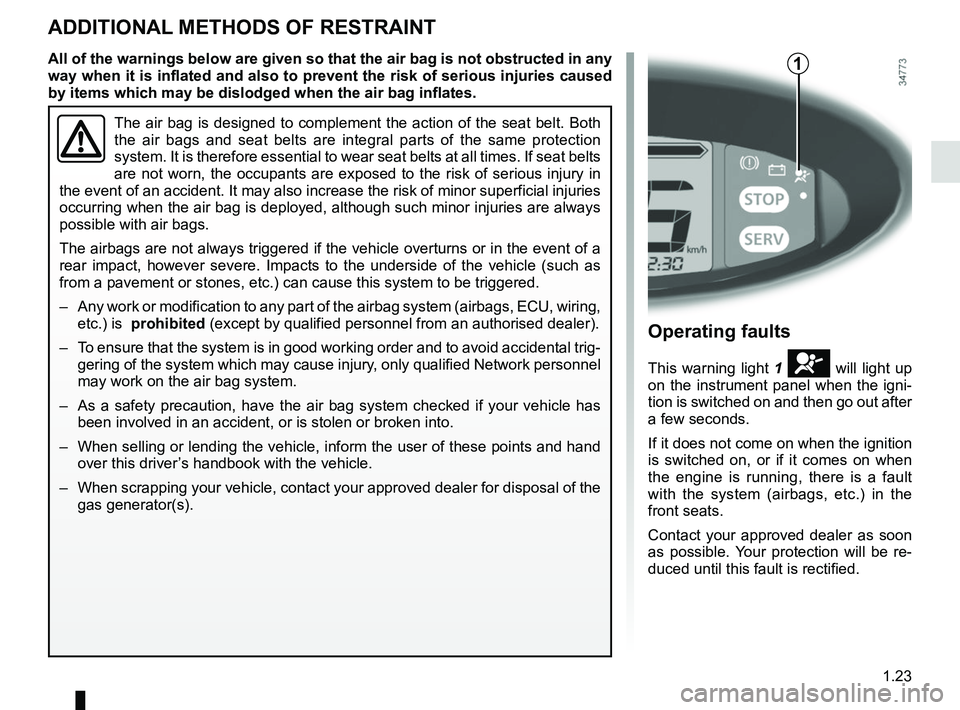
1.23
ADDITIONAL METHODS OF RESTRAINT
The air bag is designed to complement the action of the seat belt. Both \
the air bags and seat belts are integral parts of the same protection
system. It is therefore essential to wear seat belts at all times. If se\
at belts
are not worn, the occupants are exposed to the risk of serious injury in\
the event of an accident. It may also increase the risk of minor superfi\
cial injuries
occurring when the air bag is deployed, although such minor injuries are\
always
possible with air bags.
The airbags are not always triggered if the vehicle overturns or in the \
event of a
rear impact, however severe. Impacts to the underside of the vehicle (s\
uch as
from a pavement or stones, etc.) can cause this system to be triggered.\
– Any work or modification to any part of the airbag system (airbags, ECU\
, wiring, etc.) is prohibited (except by qualified personnel from an authorised dealer).
– To ensure that the system is in good working order and to avoid accidenta\
l trig- gering of the system which may cause injury, only qualified Network personnel
may work on the air bag system.
– As a safety precaution, have the air bag system checked if your vehicle \
has been involved in an accident, or is stolen or broken into.
– When selling or lending the vehicle, inform the user of these points and\
hand over this driver’s handbook with the vehicle.
– When scrapping your vehicle, contact your approved dealer for disposal o\
f the gas generator(s).
Operating faults
This warning light 1 å will light up
on the instrument panel when the igni-
tion is switched on and then go out after
a few seconds.
If it does not come on when the ignition
is switched on, or if it comes on when
the engine is running, there is a fault
with the system (airbags, etc.) in the
front seats.
Contact your approved dealer as soon
as possible. Your protection will be re-
duced until this fault is rectified.
1All of the warnings below are given so that the air bag is not obstructed in any
way when it is inflated and also to prevent the risk of serious injuries caused
by items which may be dislodged when the air bag inflates.
Page 30 of 118

1.24
CHILD SAFETY: General information (1/2)
Carrying children
Children, and adults, must be correctly
seated and strapped in for all journeys.
The children being carried in your vehi-
cle are your responsibility.
A child is not a miniature adult. Children
are at risk of specific injuries as their
muscles and bones have not yet fin-
ished growing. The seat belt alone
would not provide suitable protection.
Use a booster seat and ensure you use
it correctly.
A collision at 30 mph
(50 km/h) is the same as fall-
ing a distance of 10 metres.
Transporting a child without
a restraint is the equivalent of allow-
ing him or her to play on a fourth-
floor balcony without railings.
Never travel with a child held in your
arms. In the event of an accident,
you will not be able to keep hold of
the child, even if you yourself are
wearing a seat belt.
If your vehicle has been involved
in a road accident, replace the
booster seat and have the seat belts
checked.Driver’s responsibility
when parking or stopping
the vehicle
Never leave an animal,
child or adult who is not self-suffi-
cient alone on your vehicle, even for
a short time.
They may pose a risk of injury, such
as by starting the engine or activat-
ing equipment.
Risk of serious injury.
Driver’s responsibility
Never use the storage
space as a booster seat for
a child or a pet. Otherwise,
this could place your child or pet in
danger, or endanger the driver, in
the event of hard braking or impact.
Risk of death or serious injuries.
Page 38 of 118
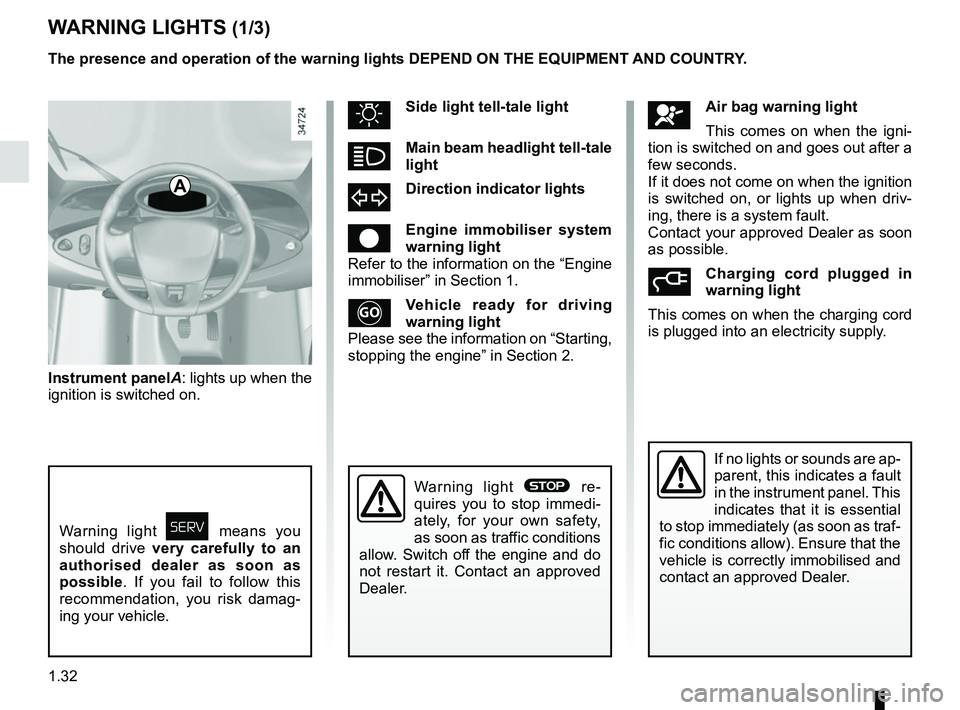
1.32
Instrument panelA: lights up when the
ignition is switched on.
WARNING LIGHTS (1/3)
Warning light ø means you
should drive very carefully to an
authorised dealer as soon as
possible. If you fail to follow this
recommendation, you risk damag-
ing your vehicle.
A
åAir bag warning light
This comes on when the igni-
tion is switched on and goes out after a
few seconds.
If it does not come on when the ignition
is switched on, or lights up when driv-
ing, there is a system fault.
Contact your approved Dealer as soon
as possible.
Charging cord plugged in
warning light
This comes on when the charging cord
is plugged into an electricity supply.
uSide light tell-tale light
áMain beam headlight tell-tale
light
dDirection indicator lights
êEngine immobiliser system
warning light
Refer to the information on the “Engine
immobiliser” in Section 1.
Vehicle ready for driving
warning light
Please see the information on “Starting,
stopping the engine” in Section 2.
If no lights or sounds are ap-
parent, this indicates a fault
in the instrument panel. This
indicates that it is essential
to stop immediately (as soon as traf-
fic conditions allow). Ensure that the
vehicle is correctly immobilised and
contact an approved Dealer.
Warning light ® re-
quires you to stop immedi-
ately, for your own safety,
as soon as traffic conditions
allow. Switch off the engine and do
not restart it. Contact an approved
Dealer.
The presence and operation of the warning lights DEPEND ON THE EQUIPMENT\
AND COUNTRY.
Page 39 of 118
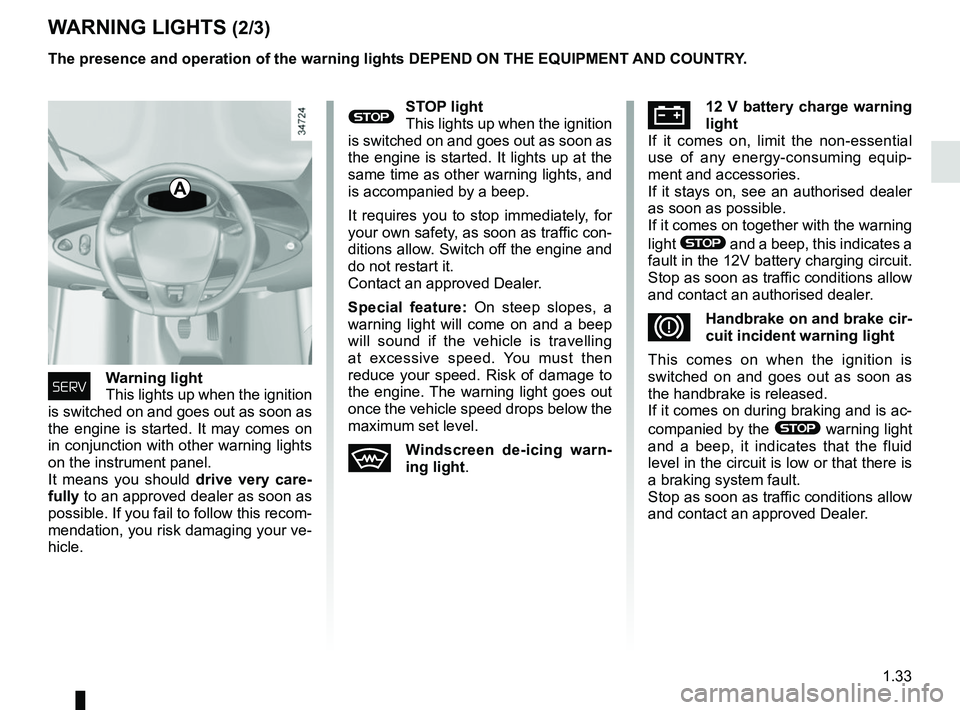
1.33
WARNING LIGHTS (2/3)
®STOP light
This lights up when the ignition
is switched on and goes out as soon as
the engine is started. It lights up at the
same time as other warning lights, and
is accompanied by a beep.
It requires you to stop immediately, for
your own safety, as soon as traffic con-
ditions allow. Switch off the engine and
do not restart it.
Contact an approved Dealer.
Special feature: On steep slopes, a
warning light will come on and a beep
will sound if the vehicle is travelling
at excessive speed. You must then
reduce your speed. Risk of damage to
the engine. The warning light goes out
once the vehicle speed drops below the
maximum set level.
Windscreen de-icing warn-
ing light .
Ú12 V battery charge warning
light
If it comes on, limit the non-essential
use of any energy-consuming equip-
ment and accessories.
If it stays on, see an authorised dealer
as soon as possible.
If it comes on together with the warning
light
® and a beep, this indicates a
fault in the 12V battery charging circuit.
Stop as soon as traffic conditions allow
and contact an authorised dealer.
DHandbrake on and brake cir-
cuit incident warning light
This comes on when the ignition is
switched on and goes out as soon as
the handbrake is released.
If it comes on during braking and is ac-
companied by the
® warning light
and a beep, it indicates that the fluid
level in the circuit is low or that there is
a braking system fault.
Stop as soon as traffic conditions allow
and contact an approved Dealer.
The presence and operation of the warning lights DEPEND ON THE EQUIPMENT\
AND COUNTRY.
A
øWarning light
This lights up when the ignition
is switched on and goes out as soon as
the engine is started. It may comes on
in conjunction with other warning lights
on the instrument panel.
It means you should drive very care-
fully to an approved dealer as soon as
possible. If you fail to follow this recom-
mendation, you risk damaging your ve-
hicle.